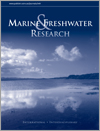Marine and Freshwater Research
Volume 76
Number 5 2025
A review of the impacts of food production on wetlands underlined the need for transforming food production to achieve sustainable wetland management. Sustainable agriculture–wetland interactions can be achieved by more efficient use of water and fertilisers, integration of crop–livestock–fish production, better support for small producers, and governance of food production that recognises the ecosystem services of wetlands in catchments.
The global water crisis, driven by unsustainable resource consumption, exacerbates drought severity and water scarcity. This assessment emphasises the utility of drought indices for evaluating regional vulnerability and monitoring patterns. It critiques large-scale engineering interventions, advocating for sustainable, nature-based management strategies. The findings underscore the necessity of global cooperation in water resource management to enhance ecosystem resilience and ensure long-term water security.
This article belongs to the collection: Global perspectives: sustainable management of freshwater ecosystems.
This study investigated how increasing temperatures influence parental care behaviour in three shrimp species (Palaemon macrodactylus, Palaemon elegans and Palaemon adspersus), with a focus on pleopod fanning. The results showed significant species-specific differences, with P. elegans exhibiting the lowest fanning rates, suggesting an efficient regulatory strategy.
We provide a basin-wide wetland vegetation classification that is simple, consistent, and reproducible, to support wetland conservation in the Murray–Darling Basin. We mapped the extent and distribution of wetland vegetation using ArcGIS Pro. We found that very few wetlands are recognised as protected areas and are unlikely to be managed through environmental flows.
Aboriginal and Torres Strait Islander peoples of Australia have lived on Sea Country for greater than 60,000 years. It is important that the ‘ecological’ in Indigenous Knowledge is prioritised in marine and freshwater research to repair, restore and sustain marine and freshwater organisms and ecosystems on Sea Country.
This article belongs to the collection: Science in Sea Country.
The evaluation of the management effectiveness of the Moulouya River Estuary in north-eastern Morocco, by using the Ramsar Management Effectiveness Tracking Tool (R-METT), has shown that management effectiveness of this site of biological and ecological interest (SIBE) is inadequate, requiring significant government conservation intervention with the support of conservation partners.
This review indicates that the presence, persistence and role of barrens and the longspined sea urchin (Centrostephanus rodgersii) seem unique in New South Wales, south-eastern Australia, and likely warrant unique management strategies between the north and far south of the state and among neighbouring jurisdictions as the species shifts its distribution.
Australian freshwater glassfishes are difficult to identify and have a confusing history, with changing species names and distributions. We examined the eastern Australian species Ambassis agassizii to clarify its taxonomy and distribution. Detailed genetic analyses identified two species within A. agassizii and found complex patterns of interbreeding with species from surrounding river basins along with intricate and often unique biogeographic patterns.





